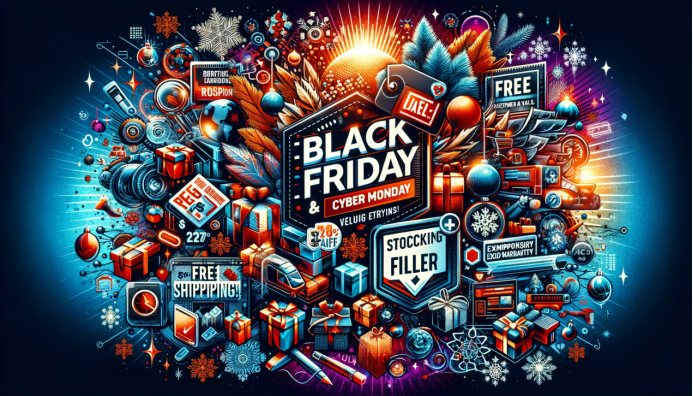
Get A Quote
20 Christmas Marketing Strategies for Your Businesses in 2023
As the year progresses and the chilly season approaches, it's a common realization that the year is swiftly passing by. This period is crucial for small businesses, as it's the ideal time to start strategizing for Christmas marketing.
Why is this timing crucial?
The last quarter of the year is packed with dates that can be advantageous for e-commerce businesses. According to a study by RCS UK, as many as 38% of consumers begin their holiday shopping in October. However, the economic landscape is changing. With inflation on the rise, consumers are looking for ways to save. This includes seeking free delivery options or choosing to buy multiple gifts from a single store. Additionally, the trend of early shopping is likely to continue as consumers anticipate rising prices, with monthly increases estimated between 6% and 8%.
Retail sales are projected to grow by 3-6%, with online sales expected to increase by 15%, including a significant 17% growth in online marketplace sales. This means more sales for businesses and increased purchasing by consumers during the peak season.
To capitalize on these trends, it's essential to have your marketing strategies ready by September, targeting early shoppers.
This guide will cover:
- Innovative Christmas marketing strategies
- Promotional ideas for both physical and online stores
- Tactics to sustain sales momentum into the new year
As autumn approaches, it's time to settle down with your favorite seasonal drink and start planning your Christmas marketing strategies. But remember, having a clear objective for your campaign is key before diving into the planning phase.
1.Set Clear Goals and Plan Strategically
Goals are essential for progress and improvement. Without clear goals, your brand might miss out on increased sales during the holiday season, rendering your e-commerce marketing strategies ineffective.
Implement S.M.A.R.T goals, an acronym for Specific, Measurable, Achievable, Relevant, and Time-based objectives. For instance, instead of a vague goal like "more sales," aim for a S.M.A.R.T goal such as "increasing overall gross profits between October & December 2023 compared to the same period in 2022."
For detailed insights on S.M.A.R.T goals, explore resources like Smart Insights' article on SMART marketing goals. Once your goals are set, think creatively about how to achieve them. This could involve boosting conversion rates, enhancing social media presence, or collaborating with influencers. Ensure your strategies align with your S.M.A.R.T goals.
2.Start Christmas Marketing at Halloween

Leverage Halloween to kickstart your Christmas marketing. Halloween marks the beginning of the holiday shopping season, and its influence extends beyond the USA, impacting businesses in the UK, Europe, and Australia.
Utilize the momentum from Halloween sales to encourage customers to return for their Christmas shopping. Maintaining Halloween imagery a bit longer can distinguish you from competitors who switch immediately to Christmas themes.
3.Enhance the Customer Experience with Custom Packaging

Custom packaging is crucial for creating a memorable customer experience, as it's the first physical interaction with your product.
Introduce unique Christmas packaging to add a sense of luxury and exclusivity, especially if paired with special edition products. For example, John Masters Organics enhanced their sales through festive-themed products and packaging. Consider options like custom gift boxes, festive ribbons, personalized tape, and more from suppliers like Packhelp.
Besides aesthetic appeal, holiday-themed packaging can be practical for customers, potentially eliminating the need for additional gift wrapping and reducing packaging waste during the holiday season.
4.Utilize Triggered Messages
Automated, triggered messages are an effective tool for re-engaging with customers. These are sent in response to specific user actions or behaviors, ensuring that each message is timely and relevant. For instance, they can be used to encourage inactive subscribers to revisit your store or to inform them about the last chance to purchase a particular item. This personal touch in communication can significantly enhance customer engagement during the holiday season.
5.Design a Festive Interactive Quiz

Engage your audience with a Christmas-themed quiz, survey, or poll. This interactive approach is not just entertaining but also a valuable method for gathering information about your new subscribers. The responses can help you tailor your email marketing campaigns more effectively. For example, you could offer personalized gift suggestions based on quiz results. Coco Village successfully used this strategy by promoting a quiz that directed users to a dedicated landing page, enhancing engagement and data collection.
6.Experiment with Christmas Email Subject Lines
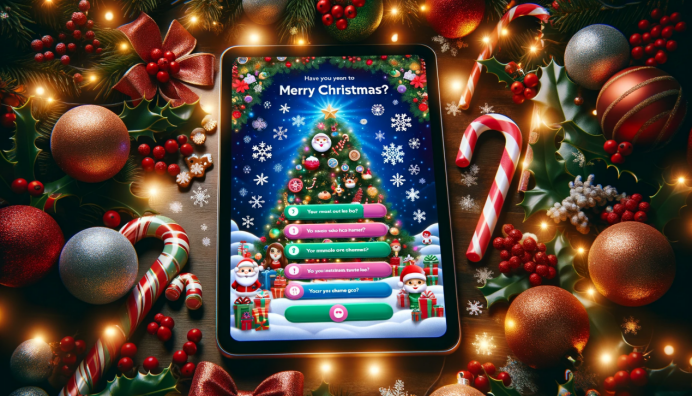
The subject line of your emails plays a crucial role in open rates. For your Christmas marketing campaign, try various festive-themed subject lines. These could be related to your quiz, special offers, or holiday greetings. The more intriguing and relevant your subject lines, the higher the likelihood of converting quiz participants into customers.
7.Strategically Position Small Gifts and Impulse Items
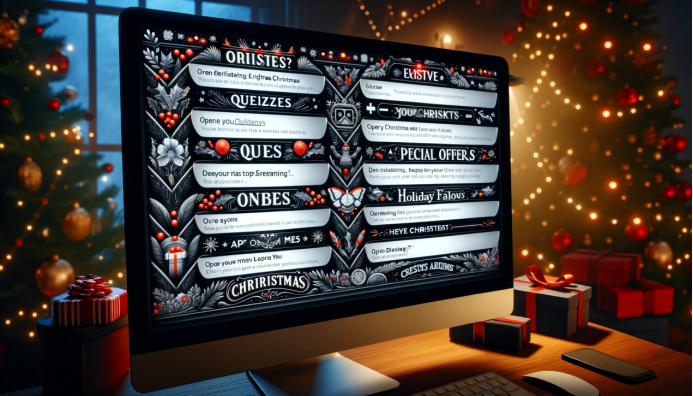
During the holiday season, a significant portion of your sales will likely come from gift purchases. With many shoppers buying for multiple people, convenience becomes key. This makes your smaller, 'stocking filler' items more crucial than ever, especially for online shoppers.
Your ecommerce store's user experience (UX) and user interface (UI) are critical here. Think about placing affordable items in easy-to-spot locations on your site, where customers can add them to their cart without hassle. For instance, after a customer adds an item to their cart, why not show them a "people also bought" or "you may also like" section at the bottom of the page?
If your store sells shoes, consider suggesting complementary items like basic socks or shoe cleaner. This can increase the average spending per cart.
8.Leverage Black Friday and Cyber Monday
These two major shopping days are essential for retail and e-commerce. Use your Black Friday and Cyber Monday campaigns to enhance your Christmas marketing. Stand out by offering more than just discounts; add value to each purchase. You could:
- Provide a year-long valid coupon,
- Include a free 'stocking filler' item,
- Offer complimentary shipping and returns,
- Give an extended warranty or guarantee.
These strategies not only boost sales but can also help grow your email list in preparation for the Christmas rush. Remember, Black Friday and Cyber Monday are just two of many holiday events you can leverage.
9.Embrace Special Days and Diverse Celebrations
The holiday season offers numerous opportunities beyond the traditional Christmas focus. For instance, Singles Day on November 11 in China is a significant event. If you have Chinese customers or those of Chinese descent living abroad, tailoring your marketing to such occasions can deepen engagement with these communities.
Consider Hanukkah, an important gift-giving festival for the Jewish community in early December. Broadening your marketing beyond exclusively Christmas-themed promotions to include winter-themed or other holiday-specific campaigns can be inclusive and effective. As Arielle Kimbarovsky from Codal suggests, this approach avoids alienating potential customers who celebrate different holidays. Remember, it's summer during Christmas for half the world!
10.Market Solutions, Not Just Products
Successful businesses excel in demonstrating how their products make life easier. For instance, a microwave isn't just an appliance; it's a time-saver for heating food. Emphasize how your products are practical solutions. For example, a multi-tool pen with a screwdriver and ruler isn't just a writing instrument; it's a handy gadget for quick fixes and measurements.
This approach applies to all products. Even common gifts like socks and underwear can be marketed as convenient solutions, saving someone the trouble of purchasing these essentials.
11.Offer Unconditional Free Shipping

In 2023, free shipping has become a standard expectation for many customers, regardless of the product size or cost. To accommodate this, you might need to slightly adjust your prices to cover shipping expenses. However, customers often overlook this minor price increase in favor of the appeal of 'free worldwide shipping'.
During the holiday season, especially the week before Christmas, consider offering free express shipping until the last possible moment. This strategy is particularly effective for attracting last-minute shoppers who are reassured they will receive their purchases in time for the holidays.
12.Maximize Sales with Upselling, Cross-Selling, and Bundles

Email marketing campaigns are greatly enhanced by incorporating strategies like upselling, cross-selling, and offering product bundles. These methods are highly effective because it's easier and more cost-effective to sell to existing customers than to acquire new ones. Marketing Metrics highlights that while the likelihood of converting a new prospect is 5-20%, the probability of selling to an existing customer is 60-70%.
For instance, Grammarly excels in upselling through personalized emails that highlight how their service has benefitted the user and how upgrading can further enhance their experience.
Similarly, product bundles are mutually beneficial for businesses and customers. Businesses sell more items, and customers enjoy the convenience of pre-selected packages. A prime example is Duluth Pack, known for its outdoor gear and apparel bundles.
13.Collaborate with Micro-Influencers
Influencer marketing, particularly with micro-influencers, is an effective tool for reaching new customers and achieving a strong return on investment. On average, businesses can expect to gain $6.50 for every $1 invested in influencer marketing. Partnering with micro-influencers whose audience aligns with your target market and brand values can significantly boost your campaign. They can create engaging content featuring your products in a holiday-themed setting, increasing brand visibility and attracting potential customers who might not be aware of your store.
14.Enhance Customer Support with Extra Live Chat Services

The holiday season often brings increased stress and queries from customers about products, services, and delivery timelines. Prompt responses are crucial; delayed replies can lead to potential customers leaving your site. Implementing live chat on your website helps in swiftly addressing customer concerns, improving their shopping experience. During peak times like Christmas, it's beneficial to reinforce your live chat service, either by increasing staff or optimizing its efficiency, to keep up with the heightened demand and convert more site visitors into customers.
15.Implement In-Browser Push Notifications
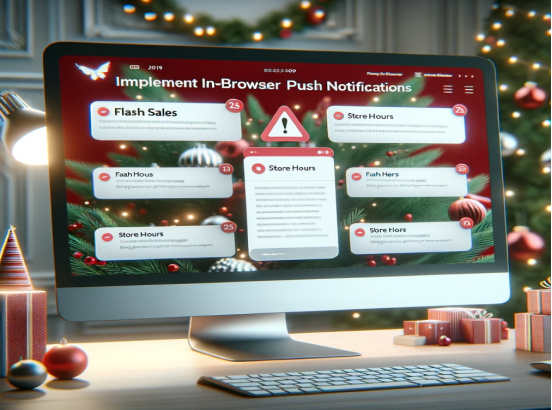
Integrating push notifications into your website during the Christmas season can be highly effective. These notifications serve as a direct communication channel with your subscribers, allowing you to inform them about flash sales, store hours, or last-minute purchase opportunities before Christmas. However, it's crucial to use this tool judiciously to avoid overwhelming or annoying your audience with excessive information.
16.Develop a Digital Christmas Catalogue
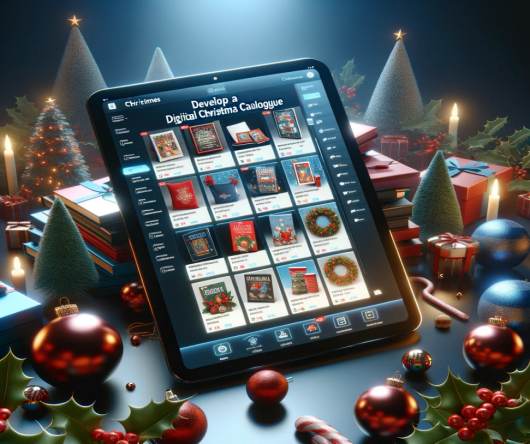
While printed catalogues are less common, digital catalogues can effectively re-engage past customers. By showcasing products through captivating imagery and quality design, you can mirror the appeal of a physical catalogue without the need for printing. Consider creating an interactive catalogue like Moore & Giles, where each product image links to its respective page on your site. This not only enhances user experience but also enables you to monitor the user flow on your website. Promote your interactive holiday catalogue through various channels like social media, blogs, and a link on your main website navigation.
17.Focus on Remarketing Strategies
Remarketing is a powerful tool that you've likely encountered. It involves displaying ads for products you've previously searched for. Although it might feel a bit intrusive, these ads are highly effective in converting interest into sales. Take Amazon's approach as an example: their remarketing strategy involves showing customers similar products to those they've viewed, encouraging them to explore more options and stay longer on the site.
18.Optimize Seasonal PPC Keywords
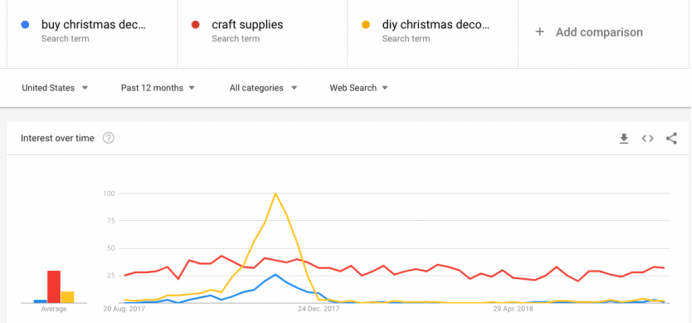
During Christmas, it's crucial to adjust your Pay-Per-Click (PPC) marketing strategies on platforms like Google and social media. For instance, while 'craft supplies' might be a popular keyword year-round, terms like ‘buy Christmas decorations’ and ‘DIY Christmas decorations’ spike in late November. By targeting these seasonal keywords at the right time, you can place your ads in front of relevant customers before costs escalate. Remember, a successful PPC campaign is grounded in thorough research and continuous testing.
19.Offer Gift Cards for Indecisive Shoppers
Gift cards are an excellent option for customers unsure about what to buy for others. The tangible nature of physical gift cards can be appealing, while digital gift cards offer convenience and reduced waste. If you're offering gift cards, ensure they are prominently displayed on your website, perhaps through a homepage graphic or a dedicated landing page. This visibility helps guide customers towards them as a viable gifting option.
20.Capitalize on Post-Christmas Campaigns
The period between Christmas and the New Year is an opportune time to continue your sales efforts. People often spend this time relaxing with family and browsing on their phones. Capitalize on this by offering a ‘Santa didn’t get me what I wanted’ flash sale to quickly move surplus products.
Dean DeCarlo, President of Mission Disrupt, suggests doubling down on the most successful campaign categories from the Christmas period during the New Year. Utilize the insights gained from your holiday campaigns to focus your budget on the most profitable strategies. Leveraging owned channels for cross-selling can also be effective in clearing out old stock and making room for new products in the upcoming year.
Summing up
And that's a wrap! Here are 25 holiday marketing strategies to spice up your Christmas season. There's a whole world of ideas out there, but these are some unique gems. Remember, time is precious during the holidays, and understanding your limits is key.
By organizing your main promotions and keeping your website and social media lively, you can save valuable time. This way, you're all set to quickly post any last-minute holiday deals or trends, without disrupting your planned content.
-Krista Fabregas, Fit Small Business
Don't forget to check out this article for essential information on holiday shipping deadlines and the final days to order your product packaging. Above all, planning and tracking everything is crucial. You never know, one of these brilliant marketing strategies might just be a hit all year round!
Want to customize your tube or box packaging solution? Leave your needs below and our experts will contact you soon!


